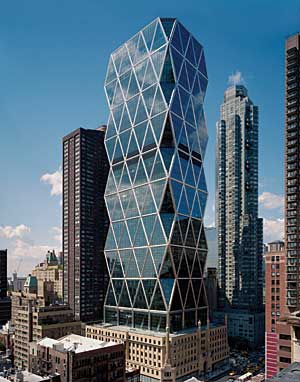Now that it has been there for a year and I’ve had my chance to learn to love it, maybe it’s a good time to say why I dislike the Hearst Tower in Manhattan so much.
The Hearst, which of course was designed by Foster + Partners, looks like a misplaced missile silo. It’s as if the Pentagon, with its usual deftness of touch, had confused its maps and located this chunk of military hardware in Manhattan instead of Florida.

It’s an office building, folks. People work there. But nothing about the Hearst, as seen from outdoors, suggests the possibility of human habitation. It appears to be a cage for a single massive object.
I don’t apologize for the image. One of the problems with Modernism, as a stylistic method, is that it tends to ignore the fact that buildings look like other things. And that’s how most people understand them. People say the abstract boxlike shapes of Modernist office towers look like the cartons the real towers came in. The world we live in is a world of resemblances.
That’s why the Brits call Foster’s London tower the “the Gherkin.” But there’s a difference. “Gherkin,” which of course means “pickle,” is an affectionate name that humanizes the building. I haven’t yet heard an affectionate nickname for the Hearst.
Parenthesis: I toured the Gherkin with a Foster partner a few days before it opened. I was charmed by it, despite the fact that much of its architecture is the product of clever solutions to problems that didn’t have to occur in the first place, since they were all the result of the building’s odd shape. Just to name one: How do you handle the window washing for a pickle-shaped tower? The boom that circles the Gherkin at waist height, and which lifts and lowers the cleaning crews like Gulliver hoisting Lilliputians, is as technically skilled as it is silly and unnecessary. The boom makes the Gherkin into an amusement park ride—resemblances, again.
More than it needs
Okay, back to Hearst. First of all, the massive exterior truss looks too big and strong to be structuring a tower that’s only 40 stories tall. It looks wasteful. I’m not a structural engineer, but I suspect some of the bold trusswork is, in fact, ornamental.
Second, the Hearst is, of course, a new tower planted on top of a six-story Art Deco building from the 1920s. I have never seen an addition to an older building that so completely refused to engage in any kind of conversation with its predecessor. Works of architecture, whatever they do, should not express contempt for the other buildings they must live among. But the Hearst, like a delinquent teen and a grandfather, thumbs its nose at its older companion.
I attended a symposium and dinner at the Hearst a few weeks ago, after having toured it 18 months earlier, while it was still under construction. I imagined that now that it was finished, at least it would be exciting to be in. Not so. You enter and immediately are confronted with an enormous waterfall with an escalator beside it, the kind of cliché you’d expect to find at a Hyatt convention hotel. The three-story shell of the old Deco building surrounds you on all sides, but nothing is done to dramatize the experience of yourself as new wine in this old bottle. You’re barely aware of the older building.


Post a comment to this article
Report Abusive Comment